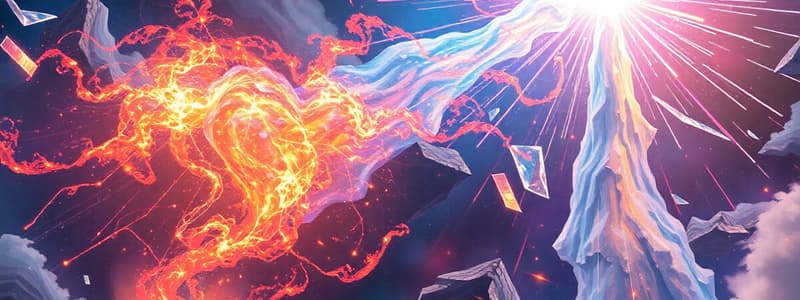Podcast
Questions and Answers
A student is holding a box stationary. Which statement accurately describes the work done?
A student is holding a box stationary. Which statement accurately describes the work done?
- The work done cannot be determined without knowing the weight of the box.
- No work is done because there is no displacement. (correct)
- Positive work is done because the student is exerting a force.
- Negative work is done as gravity opposes the student's force.
What is the standard unit of power?
What is the standard unit of power?
- Watt (W) (correct)
- Joule (J)
- Kilogram (kg)
- Newton-meter (Nm)
An elevator lifts a 500 N object 20 meters in 10 seconds. What is the power output of the elevator?
An elevator lifts a 500 N object 20 meters in 10 seconds. What is the power output of the elevator?
- 10000 Watts
- 250 Watts
- 2500 Watts
- 1000 Watts (correct)
A crane lifts a 2,000 N beam 30 meters in 15 seconds. How much power does the crane use?
A crane lifts a 2,000 N beam 30 meters in 15 seconds. How much power does the crane use?
A box is pushed horizontally with a force of 100 N across a floor a distance of 10 meters. Friction acts in the opposite direction with a force of 20 N. What is the net work done on the box?
A box is pushed horizontally with a force of 100 N across a floor a distance of 10 meters. Friction acts in the opposite direction with a force of 20 N. What is the net work done on the box?
Which action demonstrates work being done in a physics context?
Which action demonstrates work being done in a physics context?
How is the amount of work done on an object calculated?
How is the amount of work done on an object calculated?
A student runs up a flight of stairs. Which of the following changes would require the student to exert more power?
A student runs up a flight of stairs. Which of the following changes would require the student to exert more power?
Which of the following is an example of potential energy being converted into kinetic energy?
Which of the following is an example of potential energy being converted into kinetic energy?
According to the law of conservation of energy, what happens to energy when it is 'used'?
According to the law of conservation of energy, what happens to energy when it is 'used'?
Flashcards
What is Work?
What is Work?
Work is a measurement of the energy used to perform a task.
What is Power?
What is Power?
Power is the amount of work done per unit of time or work divided by time.
What is Energy?
What is Energy?
The ability to perform work or to change an object.
What is Potential Energy?
What is Potential Energy?
Signup and view all the flashcards
What is Kinetic Energy?
What is Kinetic Energy?
Signup and view all the flashcards
Law of Conservation of Energy
Law of Conservation of Energy
Signup and view all the flashcards
Study Notes
- When a task uses energy, work is being done.
- The rate of work done is measured using power.
- Power relates to work by measuring the amount of work done per unit of time.
Work
- Work, in a scientific sense, requires displacement.
- Work is the measurement of the energy used to perform a task.
- Work is solved by using the equation Force x Distance.
- The units of work are Newton-meters (Nm) or Joules (J).
- If a 200 N object is lifted 10m, the work done is 2000 Nm or J.
- If a 30 N bucket is lifted 5 m, the work done is 150 Nm or J.
- Tables don't do work because they don't move mass through a distance.
- If student A moves a 10-kg box 2 meters and student B moves a 20-kg box 1 meter, both students do the same amount of work.
- 20 J of work is done by each student.
Power
- Power is the amount of work done per unit of time, or work divided by time.
- The standard unit of power is Joules per second (J/s) which is also known as watt (W).
- If a task requires 400 J of work and takes 20 seconds to complete, the power for this task is 20 J/s or W.
Energy
- Energy is the ability to perform work or to change an object
- Energy has the same units as work, which are Joules (J)
Forms of Energy
- Potential energy is energy that is stored in the position, or structure, of an object.
- Forms of potential energy: chemical, nuclear, magnetic, and electrical energy
- Kinetic energy is the energy of a moving object.
- Forms of kinetic energy: heat, electricity, sound, and light.
- Periodic motion is vibrating like a spring, where energy changes back and forth from potential to kinetic.
Law of Conservation of Energy
- Energy can neither be created nor destroyed, it is only converted from one form of energy to another.
- Example: Friction converts kinetic energy into heat energy.
- Example: Hydroelectric dams convert kinetic energy into electricity.
Studying That Suits You
Use AI to generate personalized quizzes and flashcards to suit your learning preferences.




